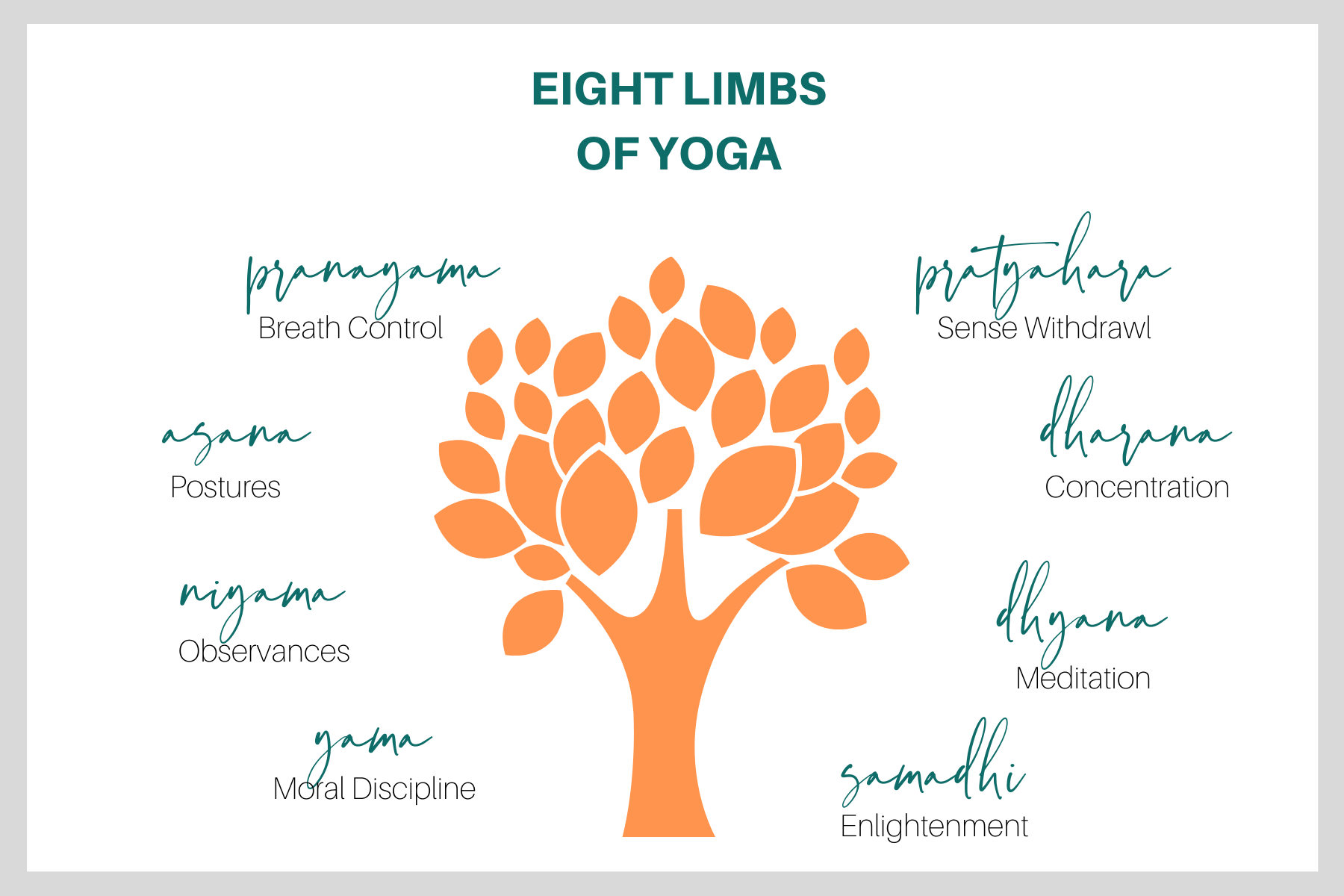The greatest gifts of yoga go far beyond the postures we do in classes. This is your opportunity to learn and apply these ancient teachings in your own life.
When I trained to become a yoga teacher I was introduced to yoga as a full philosophy. The depth of the teachings of yoga blew me away and I immediately knew I needed to share this information with everyone beyond the yoga mat.
There’s so much information to consider that I will be narrowing our focus to the yamas and niyamas, which are the first two branches of the Eight Limbs of Yoga as described by Patanjali in his Sutras, written around 400BC.
In this article I will tell you all about the yamas (restraints) and how they can be applied to your life journey. You will be able to find the niyamas (observances) in Yoga for Your Heart and Soul Part 2.
YAMAS
The Yamas traditionally guide us in how we interact with the world around us
We can also use them as a guide of how to act towards ourselves. The five yamas listed in Patanjali’s Sutras are ahimsa (non-violence), satya (truthfulness), asteya (non-stealing), brahmacharya (moderation), and aparigraha (non-attachment).
The word ‘yama’ is often translated as ‘restraint’, ‘moral discipline’ or ‘moral vow’. The word ‘yoga’ means ‘unity’, ‘wholeness’ or ‘connectedness’. We need to connect these concepts into what we do in our day-to-day lives, otherwise we won’t get to feel the full benefits of yoga.
AHIMSA (Non-violence)
Mantra – I approach all with empathy and kindness
Yoga posture – warrior I (virabhadrasana I)
The first yama, ahimsa, means ‘non-violence’ or ‘non-harming’, from ‘himsa’ – hurt, and ‘a’ – not. This is often considered the most important yama.
I have felt the impact of the intentional practice of ahimsa in my own life. Embracing kindness and empathy toward all, even those who are harmful, has dramatically changed my me. I no longer experience the rage of impatience, or feel the need to exert power over others with anger.
When we act with ahimsa in mind, it means we are not physically harming others, ourselves, or nature. We are not thinking negative thoughts about others or ourselves.
We make sure that what we do and how we do it is done in harmony, rather than harm.
The most prevalent ah-ha moment clients tend to have is about their relationship with themselves. Many note they have never considered that negative self-talk could be violence against themselves.
The most difficult aspect of ahimsa that clients experience is the idea that one can be kind to all people, regardless of that other person’s behavior. It is so ingrained in us to seek revenge upon those who injure us that to forgive becomes a foreign concept.
Try practicing radical acceptance of the world and people around you without judgment and embrace ahimsa for one day. You will never view the world or yourself the same again.
SATYA (Truthfulness)
Mantra – I live my own truth
Yoga posture – high crescent lunge (ashta chandrasana)
Without what I call ‘hardcore honesty’ we cannot live an authentic life, and therefore can never be fully satisfied or content.
The average person lies to themselves and others all the time. You didn’t know that about yourself, did you?
If you run late for things, are you totally honest about why? Do you acknowledge that you lied to yourself about how much time it takes you to get ready or to get to your destination?
Do you say you can’t do something when you don’t really know that to be true because you haven’t tried?
What little ‘white’ lies do you tell to get out of things? Or to ‘spare’ someone’s feelings?
Truth is not harmful or mean.
The delivery of a truth can be those things, but honesty itself is actually what will set you free from harm.
When you live with the truth you aren’t chained by the fear of being found out, or by the tension that builds from the unspoken.
ASTEYA (Non-stealing)
Mantra – I have all that I need
Yoga posture – warrior III (virabhadrasana III)
A personal sense of not being good enough or not having enough leaves us vulnerable to stealing. When we talk about stealing it is about far more than the taking of physical items.
The need to steal arises from a lack of faith in ourselves to be able to create what we need.
When we feel a sense of lack in life, desire, want and greed arise. We begin to look for something to fill that empty sensation, and often feel as though everyone else has what we want.
What do you steal from others? What do you steal from yourself?
Have you ever stolen time from yourself or others? Have you stolen joy? Have you robbed yourself of the opportunity to be in the moment with a loved one because you’re worried about the next moment? Have you stolen health from yourself by pushing yourself to do too much or too little?
Have you ever been so consumed with your own frantic feelings that you steal peace from others by engaging in attention-seeking behaviors?
What else can you think of that you might be stealing from yourself or others with your thoughts or actions?
BRAHMACHARYA (Moderation)
Mantra – I cultivate a life that makes the best use of my energy
Yoga posture – child’s pose (balasana)
The original translation of brahmacharya was ‘celibacy’, the idea that monks would divert sexual energy into other areas of life through celibacy. This doesn’t really fit today’s culture and has been re-interpreted to be about ‘right use of energy’ or ‘moderation’.
We get to choose how we use our energy. Do you give it all to one thing and have nothing left for another? Do you give your energy to those who do not reciprocate and find yourself at an energetic deficit?
Moderation is difficult for many to achieve in a world that supports living with all or nothing, black and white thinking.
Try eating only as much as your body needs, no more, no less. Imagine how we could all feel if we did that every day.
Own only as much as you need. I would be out of a job if you did this, but I’d be okay with it, because it would mean that no one needs to declutter their lives anymore and are choosing the peace of moderation on their own.
APARIGRAHA (Non-attachment)
Mantra – With every breath I release that which no longer serves me
Yoga posture – wild thing (camatkarasana)
Non-attachment is about the ways we stay stuck by attaching to things, people, thoughts, habits and beliefs. This important yama teaches us to take only what we need, keep only what serves us in the moment, and to let go when the time is right.
How much stuff do you own that you keep refusing to let go of even if you don’t use it any longer? How much clothing do you have that you never wear? How many sentimental items do you have that you don’t even like but you keep out of a sense of obligation?
Imagine you allowed yourself to release those items. Close your eyes for a moment and imagine those items going away. Do you feel lighter? Do you feel a sense of relief?
Now think about the people in your life. Do you maintain any relationships that no longer serve you and in fact drain you now?
Do you have any old messages or beliefs that no longer suit your life and yet you insist upon living out of those belief systems? Perhaps there are thoughts you picked up from your parents or friends that really don’t fit you. Can you let them go?
To live in this moment, not the past or the future is to feel at peace.
When you live in the now you will have no need to hold onto anything out of fear or obligation.
LIVING THE YAMAS
If you begin living by these five concepts today you will see almost immediate change. That isn’t something I say very often. Change is generally something that takes a long time. Incorporating these into a changed overall perspective will take time, but you can see the impact of the yamas as soon as you begin living with their intentions.
I will continue with the niyamas in Yoga for Your Heart and Soul: Part 2. Make sure you sign up for my newsletter so that you don’t miss out on announcements and blog posts.
For additional support in applying the Eight Limbs of Yoga to your life, set up a coaching session now and we’ll create your plan to manifest your most authentic life.







